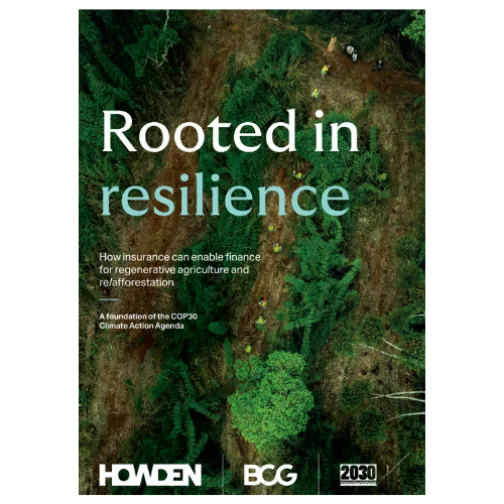Howden, BCG and Climate High-Level Champions: The role of insurance in scaling regenerative agriculture and re/afforestation

Read the report
As attention turns to COP30 in Belém, Brazil, a gateway to the Amazon and a symbol of both ecological urgency and opportunity, we have collaborated with BCG and the Climate High-Level Champions to show how insurance unlocks private capital for regenerative agriculture, re/afforestation and other nature-based solutions (NbS).
Agrifood systems are under growing pressure from climate risk, land degradation and increasing global demand. To meet climate and biodiversity goals while ensuring food security, regenerative agriculture and re/afforestation must scale dramatically.
Transitioning the world’s food systems to regenerative practices will require as much as $250–430 billion in investment annually, 6–10 times the current flows of around $44 billion1.
Meanwhile, today’s agrifood system racks up around $12 trillion a year in hidden costs2, yet attracts just 7% of global climate finance funds - of which less than one-fifth reaches small-scale producers3 . The case for de-risking investment in this sector is compelling.
A global shift is underway toward resilient agriculture and land use systems that regenerate nature and unlock sustainable growth and jobs.
Insurance can unlock these flows by lowering risk, protecting returns and accelerating the scale-up of regenerative agriculture, re/afforestation, and other NbS
Key insights from the report
Our report demonstrates how insurance can unlock private capital and accelerate the transition to regenerative practices:
- Insurance solutions already exist: weather-index insurance, transition insurance and coverage for project failure risks are already supporting farmers, investors and supply chains, with proven impact
- Insurance modelling enhances climate resilience by quantifying risks and identifying the most effective regenerative practices at national, regional and farm levels
- Agrifood systems attract just 7% of global climate finance funds. Of this, less than one-fifth reaches small-scale producers. 3
- Insurance unlocks financing. At the portfolio level, each $1 of premium spent on insurance can unlock between $3 and $10 in additional lending, reflecting the leverage effect between risk transfer and credit expansion4.
- The insurance sector has a huge opportunity to drive commercially viable growth while enabling large-scale transitions in agrifood systems
Spotlight on Brazil’s Cerrado: A $55 billion opportunity
This year’s COP location offers a dramatic setting for these discussions. Brazil’s Cerrado - a vast tropical savanna region located primarily in the central part of Brazil - exemplifies the potential of insurance-enabled NbS, with an estimated $55 billion investment opportunity by 2050 and more than 80% of this depending on purely private finance5. Unlocking this potential could transform one of the world’s most critical agricultural frontiers.
The Cerrado region is a global food powerhouse, supplying over 25% of the world’s soy, 6% of its beef, 27% of its sugarcane and 6% of its corn6.
According to modelling by BCG referenced in the report, at the portfolio level, each $1 of premium spent on insurance can unlock between $3 and $10 in additional lending, reflecting the leverage effect between risk transfer and credit expansion. While the exact impact varies by farm profitability and lender risk appetite, portfolio-level modelling in the Cerrado shows a 20–40% increase in available credit when insurance is present4.
[1] Climate Champions,Philanthropic commitment to scale and accelerate regenerative and agroecological food systems transformation (RAFT). Source
[2] UNEP & TEEB. (2020). The True Costs of Food Systems and Why They Matter. UNEP Article[unep.org]
[3] Climate Champions & ClimateShot Investor Coalition. (2023). Mobilizing Climate Finance for Agrifood Systems. Source
[4] BCG modelling. Key assumptions: The analysis is based on an average Cerrado farm archetype of 250 ha transitioning from moderately degraded pasture to regenerative soy and corn. Costs were represented using standard categories (fixed and variable), with insurance costs parameterised in line with indicative market terms (insured amount and premium share). These assumptions are illustrative and designed to capture systemic effects rather than farm specific outcomes.
[5] [6] BCG, WBCSD, CEBDS, and Brazilian Ministry of Agriculture, Resilience for the Future: A Viable Pathway to Regenerative Landscapes in the Cerrado. Source